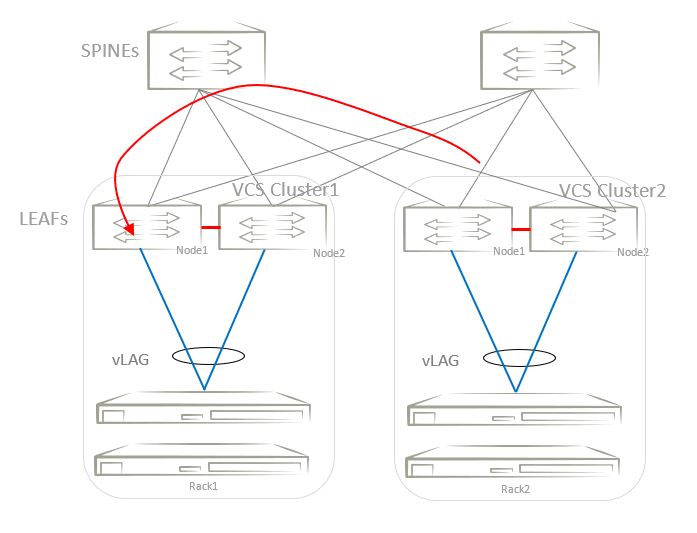Interface reload delay to prevent traffic black-holing in vLAG
The bring-up of edge interfaces before a vLAG is formed and before BGP routes converge results in traffic black-holing. The reload-delay feature addresses that problem by delaying the forming of Link Aggregation Control Protocol (LACP) on interfaces. The reload-delay command configures a global delay-time value for all interfaces on which reload delay is enabled but the delay is not specified.
reload-delay <1-3600>Global delay time (all unconfigured interfaces) configures a default delay-time value. This value is applied to the interfaces on which reload-delay is enabled but a delay-time value has not been configured.reload-delay enable <1-3600>Interface delay time; the interface configuration always takes precedence over the global configuration.
Consider the two following scenarios.
Scenario 1
Node1 in VCS Cluster1 is reloading. The vLAG between Node1 and Node2 is not formed yet, but the BGP session between leaf and spine nodes is established. Servers could start load balancing the traffic to Node1, but that traffic is black holed as the vLAG is not formed yet.

Scenario 2
Node1 in VCS Cluster1 is reloading. Routing protocols between leaf and spine nodes could be converging before all tunnels are formed in Node1. Spine nodes could start load balancing the overlay traffic to Node1, but all this traffic could be dropped as the tunnels are not yet formed in Node1.

After a switch reload, interfaces on which reload-delay is enabled remain administratively down for at least the delay-time configured by the user. After this time, the interface becomes administratively up.
For graceful vLAG host-traffic restoration, the reload delay must be configured on client interfaces such as physical interfaces and vLAG/port-channel interfaces. For graceful spine-traffic restoration, reload delay isconfigured on a loopback interface whose IP address is used as the source IP address of a tunnel end point. The routing protocols become aware of the tunnel interfaces only after the specified reload-delay time, after the tunnel has been established. This avoids traffic black-holing.
Configuration examples
device# configure terminal device(config)# interface port-channel 10 device(config-Port-channel)# reload-delay enable 1200
device# configure terminal device(config)# int eth 0/12 device(conf-if-eth-0/12)# reload-delay enable 1600 Newly configured reload delay value will be applicable after system reload. device(conf-if-eth-0/12)#
device# configure terminal device(config)# interface loopback 10 device(config-lo-10)# reload-delay enable 1200
device# configure terminal device(config)# reload-delay 1800
device# show interface port-channel 10
Port-channel 10 is admin down, line protocol is down (admin down)
Hardware is AGGREGATE, address is d884.66e9.fb60
Current address is d884.66e9.fb60
Interface index (ifindex) is 671088650 (0x2800000a)
Minimum number of links to bring Port-channel up is 1
MTU 1548 bytes
LineSpeed Actual : Nil
Allowed Member Speed : 10000 Mbit
Priority Tag disable
Forward LACP PDU: Disable
Route Only: Disabled
Tag-type: 0x8100
Reload delay time: 1200, Remaining time: 975
Last clearing of show interface counters: 00:03:45
Queueing strategy: fifo
Receive Statistics:

